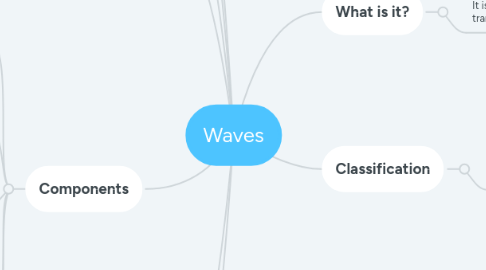
1. v = d/t
2. Displacement-Time Graph
2.1. shows the period
2.2. describes the change of displacement of ONE particles on a wave as time passes
3. Wavefront
3.1. gap between two wavefronts = 1 wavelength
3.2. study the definition. Also it is imaginary
4. sound of diff pitches travelling in the same medium
5. What is it?
5.1. It is a phenomenon where by energy is transferred but matter is not.
6. Classification
6.1. compare the direction of wave vs direction of vibration of the medium
6.1.1. They are parallel
6.1.1.1. Longitudinal waves
6.1.1.1.1. Sound wave
6.1.1.1.2. Ultrasound
6.1.1.1.3. Slinky
6.1.2. They are perpendicular
6.1.2.1. Transverse waves
6.1.2.1.1. Light
6.1.2.1.2. EM Spectrum
6.1.2.1.3. Water wave
6.1.2.1.4. Slinky
7. Components
7.1. Wavelength
7.1.1. peak-peak
7.1.2. tough-tough
7.1.3. sine curve
7.1.4. may change depending on the situation.
7.1.4.1. water wave travel from deep to shallow, vice versa
7.2. Period
7.2.1. time taken to produce 1 complete wave
7.3. Frequency
7.3.1. most of the time, a constant. E.g. water wave
7.3.1.1. no. of complete waves produced in 1 sec
7.3.2. can only be change at the source
7.3.3. stays constant when water travel from deep to shallow depth, vice versa
7.4. Amplitude
7.4.1. Max displacement from undisturbed position
7.4.2. indicates the amount of energy the wave is carrying
7.5. Speed
7.5.1. given by the distance the crest travel per unit time
7.5.1.1. v = d/t
7.5.2. v = f (wavelength)
8. Formulas
8.1. f = 1/T
8.2. v = f (wavelength)
9. Representation
9.1. Displacement-Distance (or Position) Graph
9.1.1. shows the wavelength
9.1.2. describes the displacement of ALL particles along wave at a particular time (time is frozen)
9.1.3. Speed of wave can be found if you know how far one wavefront travels and takes how much time.
